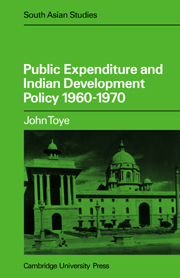Book contents
- Frontmatter
- Contents
- List of Tables
- Preface
- List of Abbreviations
- Introduction
- PART ONE GENERAL
- PART TWO EMPIRICAL EVIDENCE
- 4 The fiscal performance of the public sector
- 5 Public expenditure and the industrial recession
- 6 The degree of public expenditure centralization
- 7 The growth of state governments' spending
- 8 Public investment, public saving and the state governments
- PART THREE CONCLUSIONS
- APPENDICES
- List of works cited
- Index
5 - Public expenditure and the industrial recession
from PART TWO - EMPIRICAL EVIDENCE
Published online by Cambridge University Press: 09 January 2010
- Frontmatter
- Contents
- List of Tables
- Preface
- List of Abbreviations
- Introduction
- PART ONE GENERAL
- PART TWO EMPIRICAL EVIDENCE
- 4 The fiscal performance of the public sector
- 5 Public expenditure and the industrial recession
- 6 The degree of public expenditure centralization
- 7 The growth of state governments' spending
- 8 Public investment, public saving and the state governments
- PART THREE CONCLUSIONS
- APPENDICES
- List of works cited
- Index
Summary
The examination of general trends in public expenditure and other public finance variables in the previous chapter showed the strong contrast between the first and the second half of the decade. Broadly, the first five years might be characterized as years of growth, and the second five years as years of recession. The event which marks the boundary between these two subperiods is the onset of severe drought in 1965.
It is natural to raise the question whether the drought of 1965–67 is to be regarded as an exogenous factor which directly caused the economic recession after 1965, to which levels of public expenditure were then adjusted, or whether public expenditure played a more active role in provoking the recession. The extent to which government policy was itself responsible for provoking the recession was debated publicly in India in the late 1960s. Positions on the question have more recentlybeen taken by economists analysing the 1966 devaluation of the rupee. The early debate was inconclusive because of the non-availability of relevant statistics (as will be argued at length in this chapter). The later foreign trade economists have also not gone very fully into the question, since to them it is of peripheral interest. With the later and more refined public expenditure statistics now available, it is opportune to re-open the debate. That is the aim of this chapter.
- Type
- Chapter
- Information
- Public Expenditure and Indian Development Policy 1960–70 , pp. 119 - 136Publisher: Cambridge University PressPrint publication year: 1981

